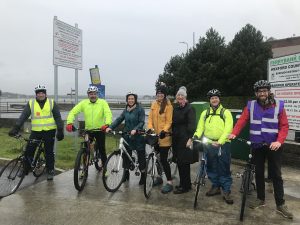
It looks like we have a new government which includes an impressive €360,000,000 for cycling and walking infrastructure.
For this particular blog, I will be visiting some poorly thought out cycling projects that Wexford Co Co has delivered and why I think some oversight as proposed by the programme for govt. could be good.
(Equally, this could apply to many local authorities countrywide).
*full cycling transport section from programme for govt below article.
The cycling section from The Programme for Government is quite ambitious not just in terms of money allocated to it, but also in ambition.
There’s a lot to it, but in a snapshot, it mandates that every local authority, with assistance from the National Transport Authority (NTA), adopts a high-quality cycling policy, carries out an assessment of their roads network and develops cycle network plans, which will be implemented with the help of a suitably qualified Cycling Officer with clear powers and roles.
Further to this it is proposed to have 7 Regional Design Offices for roads, to support local authorities.
All of this is crucial to overall value for money delivery.
Leaving this solely to councils such as Wexford Co Co to determine what “high-quality” means to them may simply be a waste of more road paint.
Unless we witness an unlikely road to Damascus moment, I feel the best way to achieve this is with some national oversight.
For this to realise the success of this ambition, I believe that the overall assessment of roads networks and development of cycle network plans must be based on an approved national standard; these assessments and cycle network plans should be approved by a central national authority rather than the local council.
Just so that we are clear from the off, I am not a road engineer but I have been on a Dutch cycling study tour, where we studied its world famous cycling infrastructure. I’m a cycle right trained cycling instructor and an award winning road safety advocate who cycles around 12,000 kms/annum for sport, leisure and transport.
I intrinsically know what feels safe when I cycle and I crave for things to be better so that cycling doesn’t just remain the preserve of the brave.
Over the years, I have had many discussions with council officials in an effort to help improve matters. I don’t feel that in the intervening years, matters have improved to any extent in that regard which is why I broadly welcome some oversight as per the programme for government in this area.
Cycling infrastructure in Co. Wexford ranges from the well meaning to the box-ticking to the downright dangerous and everything in between.
Here’s 8 reasons why cycling infrastructure in Co. Wexford is failing & why I feel it needs to be standardised and overseen
by a national body.
Phil.
Chair WexBUG
1. IT’S NOT ALL ABOUT THE MONEY.
A. The R730 €648,100 Drinagh refit.
https://wexbug.org/what-is-it-about-cycling-in-drinagh/
Wexford Co Co had rightly identified this road as ‘an area with almost complete dependency on car travel’ so this project was to entice car users out of their vehicles on to more active modes such as walking and cycling.
The solution included the removal of a town bound cycle lane to be replaced by what would turn out to be a dangerous, poorly designed shared path.
According to RSA data from cycling collisions 2005 – 2016, there was one such collision on this road in that full 10 year period, yet I’m aware of at least 2 requiring hospital treatment since the refit.
Indeed Wexford General Hospital’s ED consultant, Paul Kelly pointed out ‘..We have seen a number of incidents with the Drinagh cycle path, the cyclists concerned mentioned the design of the path as the primary reason for their falling’
B. Clogh https://wexbug.org/that-clogh-cycle-lane/
The €82,625 project to develop the cycle ways on the N11 (R772) from Gorey to the Tinnock and Clogh roundabouts, with the aim of creating a 20km loop north and south of the town.
In practice this project involved the expensive application of road paint inside existing hard shoulders effectively narrowing existing spaces designed primarily for cyclists and pedestrians in the first pace. The actual loop never materialised due to not joining it with Gorey itself.
Even parts of this where a narrow hard shoulder existed, the road paint craze continued effectively narrowing a mandatory cycle lane to 9 inches wide in parts.
Now that’s a lot of very expensive paint for little gain.
(No extra tarmac was harmed in the completion of this project).
2. POORLY THOUGHT OUT DESIGN.
This section could include the non existence of contra flow cycle lanes, cycle lanes that end abruptly, the lack of even one single segregated metre of cycling infrastructure, some overly narrow cycle lanes designed with the intention of getting the cyclist out of the way rather than with the prime focus on enticing a rider to switch transport modes despite council overtures.
But let’s shine a light on to Wexford Co Co’s most recent foray into cycling infrastructure, The Newtown Rd. in Wexford townhttps://wexbug.org/racecourse-cycle-lane-review/
This involved a full existing road resurfacing and the replacement of hard shoulders with (you guessed it) a different type of magic road paint. Heading west, the cycle lane ‘veers’ out on to the main carriageway in order to provide kerbside parking. This places the bicycle rider in to a dangerous area known as the door zone.
A better safety outcome is provided for when car parking spaces protect the cycle lane — cycle lanes should be placed between the parking and footpath kerb and should not be placed between the parked cars and moving cars as per image below.
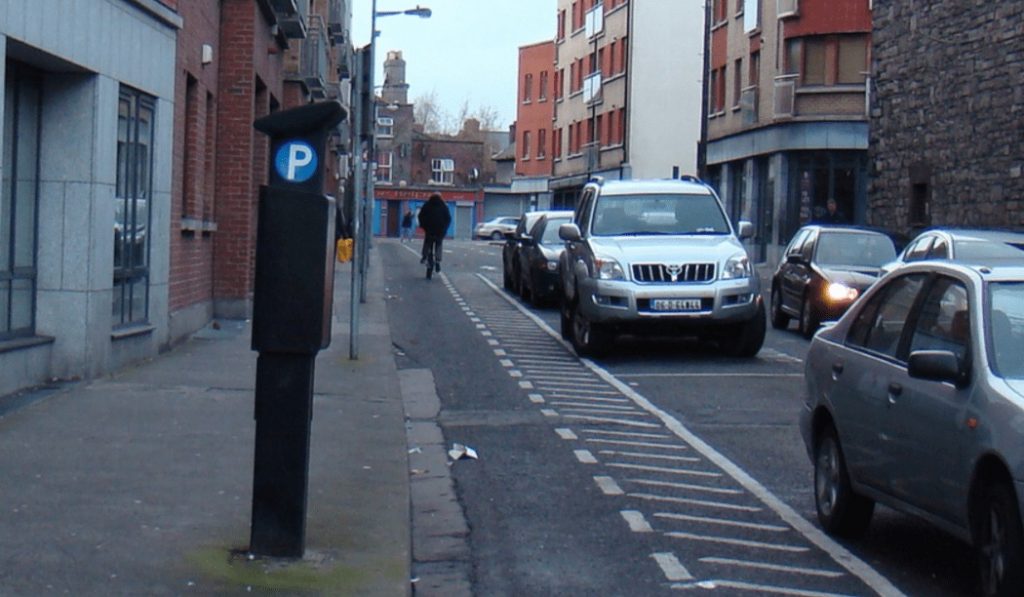
On race days this area is a free for all and parking in these mandatory cycle lanes is something an official blind eye is turned to.
Indeed it has been defended by some council officials.
This of course excuses and actually encourages lawlessness and 2 parked cars are a regular feature heading east before Boggan’s. They of course would have every right to point out the rampant illegal parking on race days to contest any fine for this illegal behaviour and so the problem perpetuates..
A simple solution to that particular problem might have come in the guise of putting in local restrictions of ‘race days only’ so that it was clear that outside of those times, this behaviour would not be tolerated.
This project is a masterclass in conflict creation.
3. EXCLUSION OF CYCLING INFRASTRUCTURE ON NEW ROADS.
We built some beautiful new roads here in Co. Wexford recently without so much as a thought for cycling infrastructure.
Not doing so on the newly constructed RFK bridge in particular was shortsighted in the extreme.
What a view opportunity for cycle tourists and locals alike, with so many attractions on its doorstep. The view is particularly good from the bridge and the addition of footpaths and cycle lanes would have been an attraction in itself. Instead many will just contend with a fleeting view from a car window.
With NTA guidance, could this have been different?
4. GIVING UP AT JUNCTIONS.
According to latest RSA research, junctions were associated with just over half (51.1%; 496) of cyclist injuries, yet Wexford Co Co hasn’t succeeded in joining one single junction for cyclists in the whole of the county.
Even places where there are cycle lanes already at both sides of a junction, the cyclist is left in no man’s land trying to cross over.
This is something seen as vital for less experienced cyclists and there are many solutions available.
It’s unfortunate that to date, none has been considered or implemented.
5. THE GENERAL LACK OF CYCLE LANES IN THE COUNTY
Apart from Wexford and Gorey, there are no cycle lanes in any of the other Co.Wexford towns. This leaves sizable towns such as Enniscorthy, New Ross, Bunclody, Ferns etc with no cycling infrastructure whatsoever.
6. POORLY MAINTAINED ROAD SURFACES ON OFFICIAL CYCLE ROUTES.
Some of the surfaces on these roads such as the EuroVelo1 route were already quite poor but this has been compounded with the recent application of tar and large chip dressings.
https://wexbug.org/rough-roads/
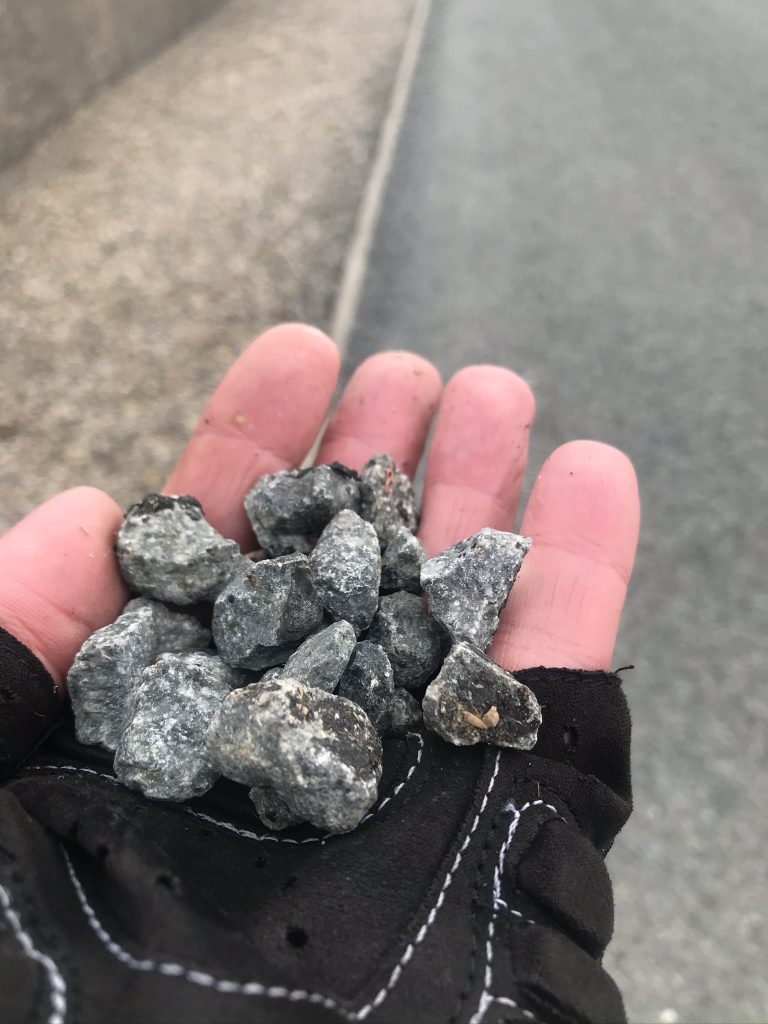
Using tar and chip dressing surfacing on cycle routes does nothing to entice cycle tourists to the area. This surface becomes extremely bumpy once laid and to fall from a bicycle on this type of surface is like falling on a cheese grater.
This large chipping tar and chip dressing was recently applied to a key section of the council’s own EuroVelo1 route along the Hook peninsula.
Below you’ll find some random comments from people who have cycled there.
No amount of spin from the council can negate the end user experience. https://wexbug.org/size-matters/
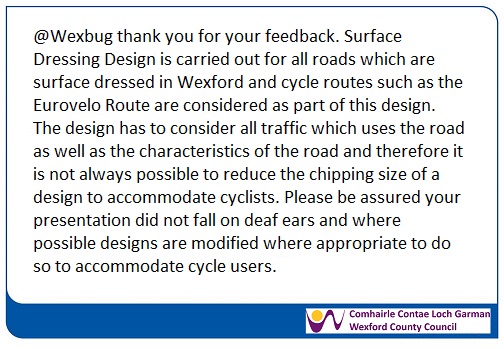
I cycled it Saturday for the first time in 3 months to see if it had improved. It will be my last time on it, its way too rough. I had noticed up to before the lockdown that the amount of cyclist using it had declined dramatically. It is sad for the local coffee shops etc who will be losing some customers at a time when they could do with as much support as possible
I’ve ridden that stretch 17 times in the last 15 months. Quality of the new surface is very poor. Ironically it was far far better before it was resurfaced last year.
I won’t use that road, because of the shocking surface. The stretch beyond Wellingtonbridge along by Whites Garden centre isn’t much better. As long as its ok in a car, they dont give a damn.
Likewise, i wont use Castlebridge to Wexford either – they resurfaced it last year and made it 5 times worse than what it was. Again, they don’t care.
The Fáilte Ireland cycle routes have confusing signage, navigate through dangerous right turns, have generally poor surfacing and are consequently little used.
7. LACK OF CONSIDERATION FOR SAFE CYCLING IN ROAD REFITS
A. The recent reconfiguration of the N25 approaching Whitford Hotel.
The council approached the TII (Transport Infrastructure Ireland) to add a left turn only towards town. This has meant that the most vulnerable road user would now need to merge to the right lane amongst 100km/hr traffic in order to go straight towards Rosslare. No alternative has been considered for bicycle riders and this continues to present a very dangerous situation.
(According to sports app Strava, heat map, this is one of the county’s prime cycling routes.)
B. The inclusion of a mini roundabout at the junction of Sinnottstown Lane and the R730 in Drinagh.
As you can see from the image below, there is a mandatory cycle lane that runs alongside this new roundabout.
You will also see from the second image that lorries turning right from Sinnottstown Lane need to encroach the cycle lane in order to make this turn.
The important thing to remember here is that children as young as 12 may be cycling independently along this section and while they should yield to traffic coming from the right, the possibility of a high vehicle alongside the rider on the approach may obstruct that sight line and also may not expect a vehicle to encroach the cycle lane they are riding in.
Making a simple mistake should not potentially cost a young rider’s life.
This is why the design is crucial here.
I believe that in order to make this safer, that the cycle lane should be rerouted before this point in the road but in the trial period, the lines on the road should have been burned off, to save confusion.
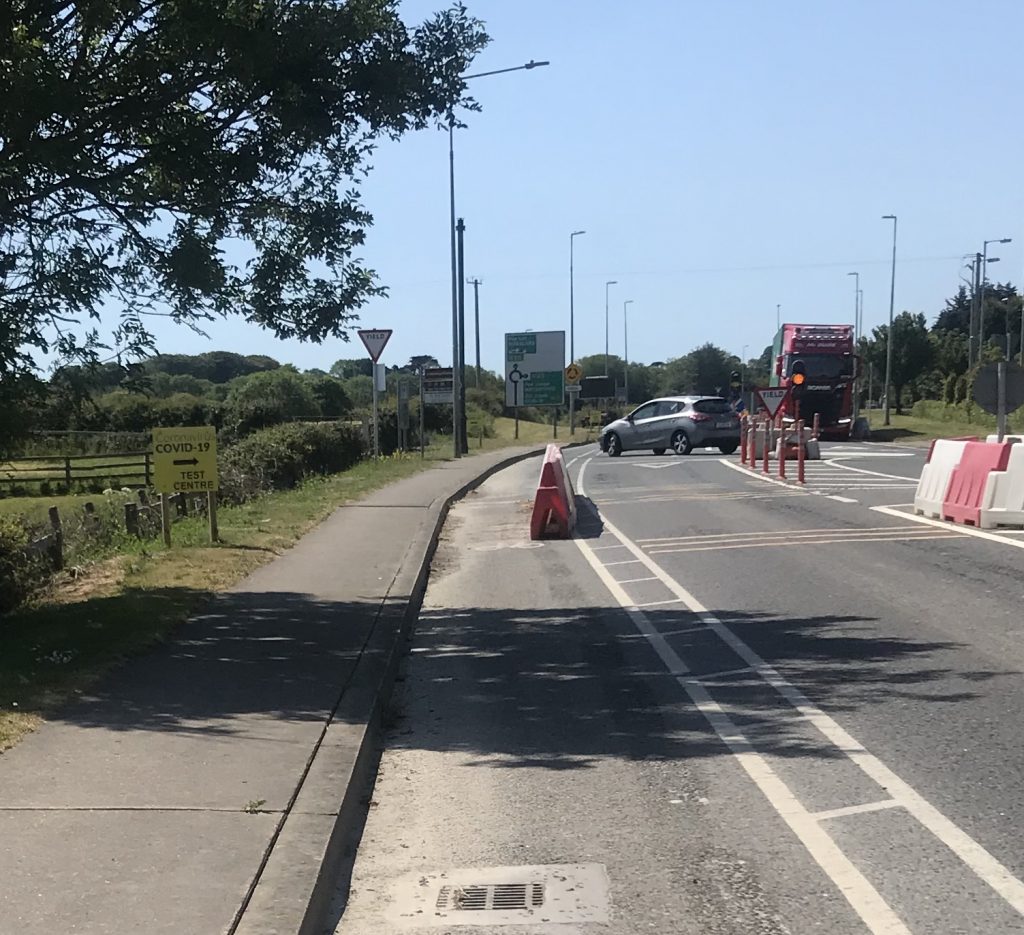
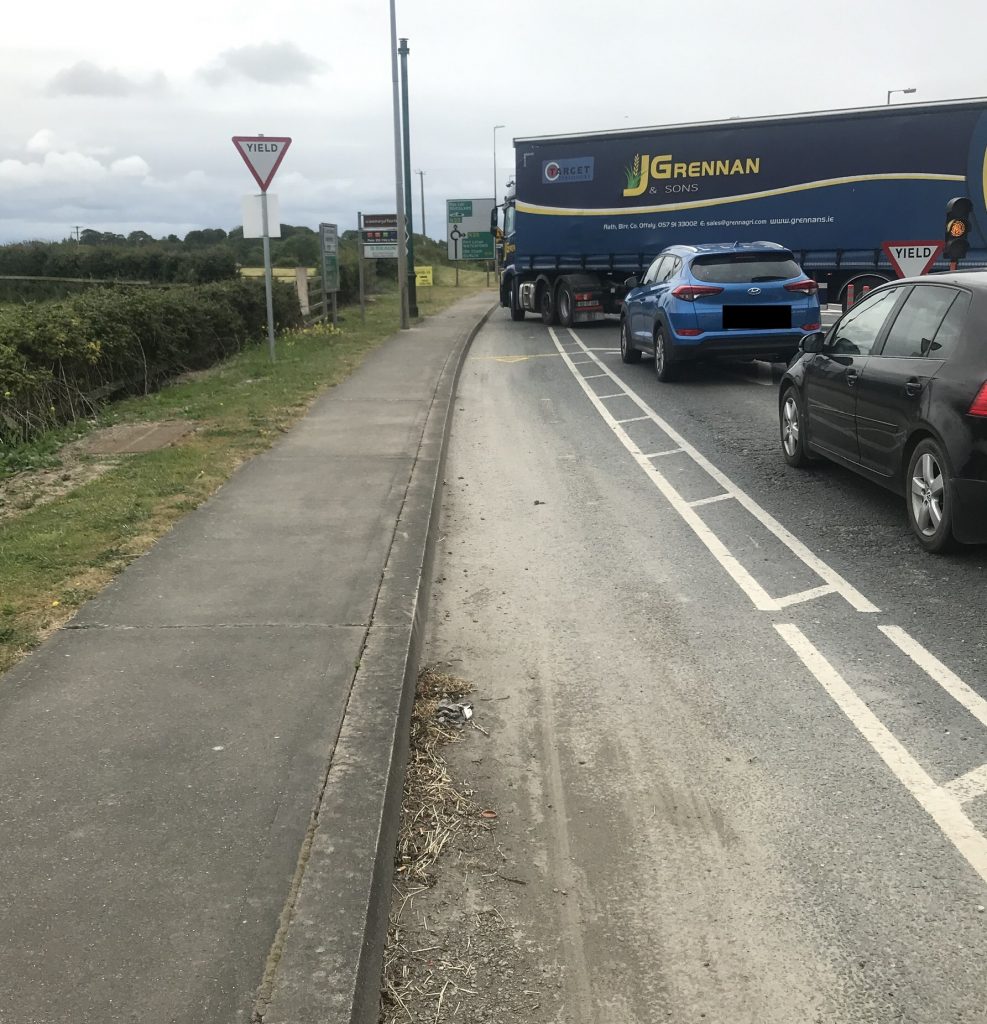
8. POOR OFFERING = POOR UPTAKE.
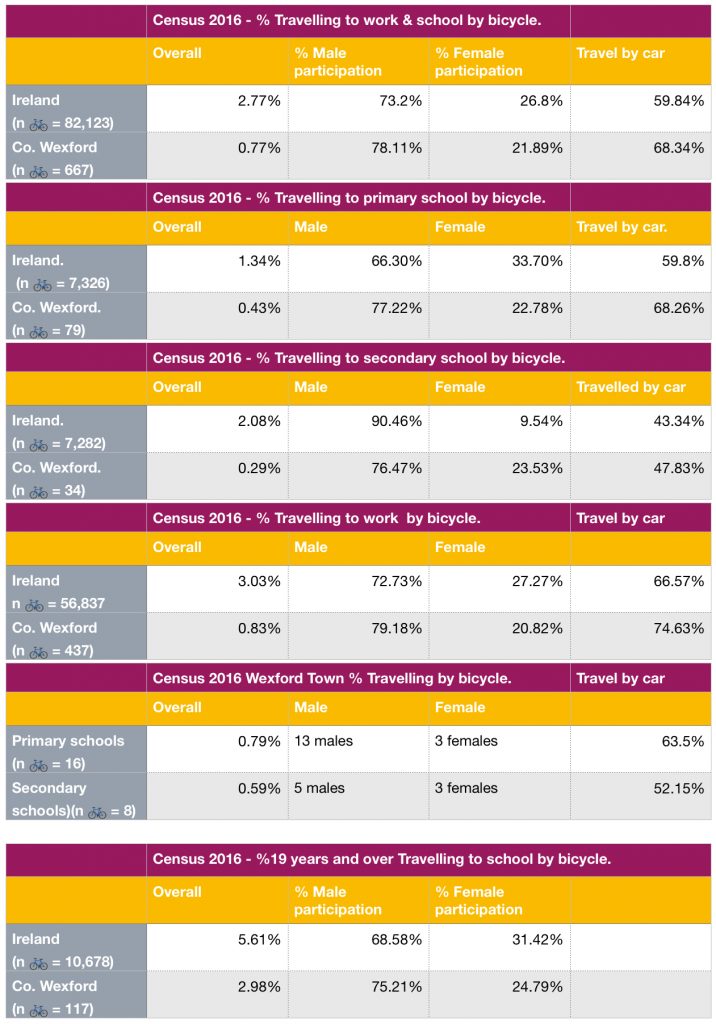
The lack of joined up thinking over decades both nationally and especially locally, has led to the poor uptake in everyday transport cycling and a lot of good money has been wasted on projects that deliver little despite much promise.
The perceived dominance of a ‘windscreen view’ of traffic management has probably paid a large part in bringing us to this point.
Hopefully this new proposed format, triple A cycling for All Ages and Abilities will become enabled through the catalyst of the Programme for Government.
But this vision and imagination could all count for nothing if our council do not show the required leadership.
There is now €1,000,000 per day up for grabs and we need to claim our high quality lion’s share.
Opportunity knocks!
Is Wexford County Council up for the challenge?
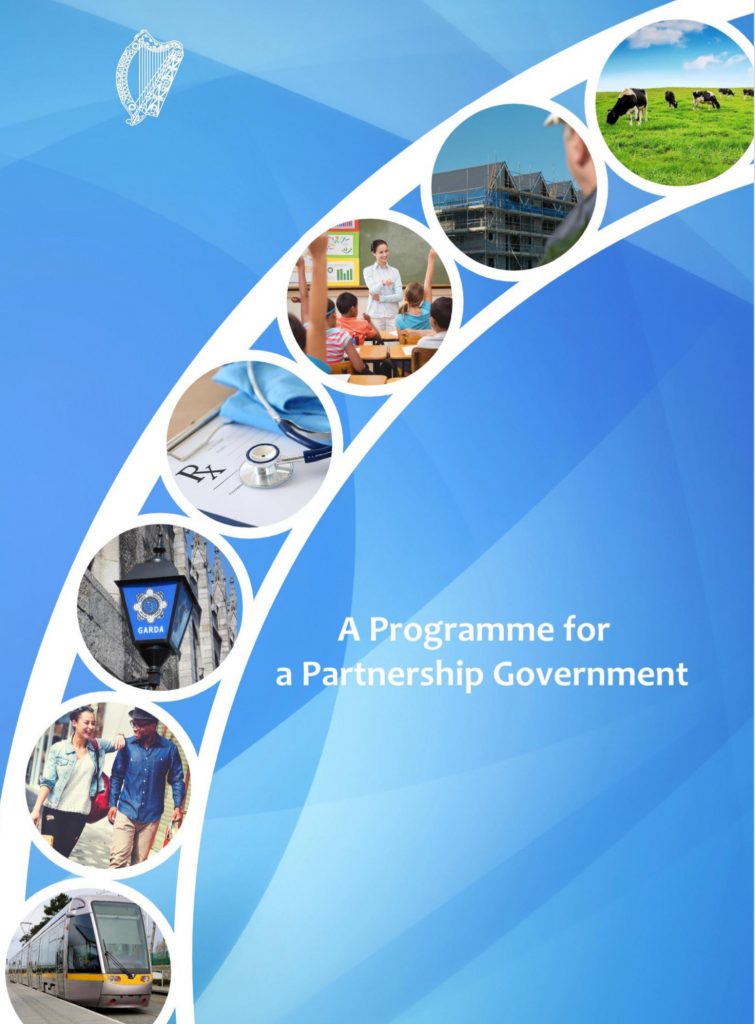
Each local authority will be immediately mandated to carry out an assessment of their road network to see where space can be reallocated for pedestrians and cyclists. This should be done immediately.
Cycling and electric cycling have enormous potential to facilitate a high proportion of daily trips if we provide an environment which protects and prioritises this mode of transport. We will promote cycling and pedestrian safety and enable this through improved design, increased separation and better signage and marking.
The Government will commit to an allocation of 10% of the total transport capital budget for cycling projects and an allocation of 10% of the total capital budget for pedestrian infrastructure. The Government’s commitment to cycling and pedestrian projects will be set at 20% of the 2020 capital budget (€360 million) per year for the lifetime of the Government.
This commitment will deliver a five-year, multi-annual funding programme linked with a specific target of new separated cycling and walking infrastructure which will be delivered or under construction by end 2024. This will enable a step change in the number of people taking daily journeys by foot and bicycle which will help improve quality of life and air quality.
The total spend on walking and cycling infrastructure includes committed funding from Department of Transport, Tourism and Sport for active travel, greenways and an agreed pedestrian and cycling allocation from the Bus Connects programme.
Additional funding to meet the annual ceiling will be provided through the Recovery Fund with a focus on jobs-intensive infrastructure.
This funding will be subject to the normal rules in relation to the carry forward of capital funding.
In addition to this expenditure commitment we will undertake other measures to help enable the continued increase in the numbers of people walking and cycling each day.
We will:
• Mandate that every local authority, with assistance from the National Transport Authority (NTA), adopts a high-quality cycling policy, carries out an assessment of their roads network and develops cycle network plans which will be implemented with the help of a suitably qualified Cycling Officer with clear powers and role.
• Expand and enhance the expertise on active travel needed to dramatically improve infrastructure and participation both in the NTA and local authorities, including by establishing Regional Cycle Design Offices, co-located in the seven Regional Design Offices for roads, to support local authorities.
• Dramatically increase the number of children walking and cycling to primary and secondary school by mandating the Department of Transport to work with schools across Ireland, local authorities, the Green Schools programme and local initiatives, including Cycle Bus and School Streets.
• Widen the eligibility of the Bike to Work scheme. We will provide an increased proportionate allowance for e-bikes and cargo bikes.
• Ramp up the Cycle Right programme to ensure that all children are offered cycling training in primary school.
• Conduct a review of road traffic policy and legislation to prioritise the safety of walking and cycling.
Greenways
We will lead the development of an integrated national greenways strategy. This has the potential to transform modal shift, improve air quality and public health.
This commitment to cycling will enable us to achieve the huge ambition of developing an integrated national network of greenways to be used by commuters, leisure cyclists and tourists. We will continue the coordinated approach between central government, local authorities and agencies to deliver on this ambition.

